Past and Present: Testing the Waters
A look at Brooklyn, then and now. There are a lot of everyday things we take for granted, living in the greatest city in the world, and one of them is the assurance that when we go to the sink and turn the tap, we’ll be getting clear, pure water. As you probably know, today…
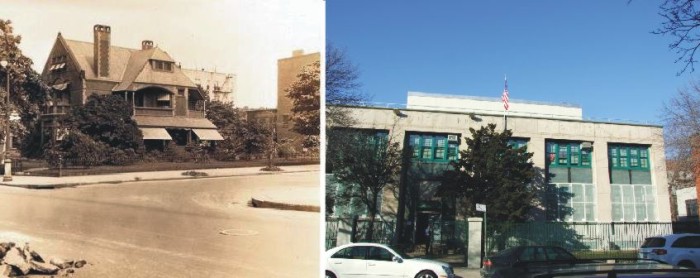

A look at Brooklyn, then and now.
There are a lot of everyday things we take for granted, living in the greatest city in the world, and one of them is the assurance that when we go to the sink and turn the tap, we’ll be getting clear, pure water. As you probably know, today New York City’s water comes from the upstate reservoirs of the Catskills and the Delaware River basin. It’s arguably the best municipal water system in the world.
For Manhattanites, that system began in the mid-19th century with the creation of the Croton Aqueduct. That was a remarkable feat of engineering that brought water into reservoirs in Manhattan. It was upgraded in the late 19th century with a second aqueduct. During those years, that was Manhattan’s water. Since Brooklyn was still an independent city at the time, we needed to get our own water.
Brooklyn is part of Long Island, so it shouldn’t come as any surprise that the city’s earliest water supply came from further out on the island. The water was pumped in underground and collected in a reservoir on the Brooklyn /Queens border, atop what is now Highland Park. That was the Ridgewood Reservoir, and was first established in the early 1850s. The city still needed a more local reservoir to supply the western part of the city, so in 1856, they began constructing a reservoir on the second highest plateau in Brooklyn – Mount Prospect.
Mount Prospect had played a key role as a lookout site for the Continental Army during the Revolutionary War, during the Battle of Brooklyn. It rose 200 feet above sea level, and so was a perfect spot for a reservoir that could then send water down to the city of Brooklyn below. The lake was completed in 1858, and the water was pumped in from underground pipes stretching from East New York.
The reservoir was quite large, covering three and a half acres, and was 20 feet deep. It held 200 million gallons of water. The best water systems are gravity fed, and since Mount Prospect was higher ground than Ridgewood, it was better suited to deliver water to those parts of the city south of Atlantic Avenue. The water was pumped through a pump house that stood at the edge of the reservoir, where it was pressurized to then shoot it out into the system. In 1891, the city fathers wanted more water pressure, so a large water tower was built. Water flowed up and down the pipes in the tower, further pressurizing it, enabling the system to have a better water flow.
The tower had another advantage; it was beautiful, as was the artificial lake beside it. The structure, designed by architects Henry W. Thayer and William J. Wallace, was constructed in pale pink granite, and had a stairway to the top, from which the entire city, plus Manhattan, New Jersey and Staten Island could be seen. The entire reservoir was a popular tourist spot, as was, of course, nearby Prospect Park.
Because the water in the lake was open to the elements, it needed testing for purity on a regular basis. A laboratory was needed to perform this important task, and that lab needed to be near the reservoir. In 1897, the building on the left side of the screen was completed, and stood at 353 Underhill Avenue. It was the water testing lab for the reservoir. The surrounding neighborhood of Prospect Heights was still being constructed on the surrounding blocks. Most of the houses in the vicinity of the corner of Underhill Avenue and Park Place were built between 1890 and 1905.
The lab was designed to fit into the neighborhood; it looked like a residence, not an official city structure. It would serve as the city’s water testing laboratory until it was replaced by the current building in 1938. That unique Moderne style building was designed by the prominent architect Aymar Embury II for the Department of Water Supply, Gas & Electric of the City of New York. Embury is most famous for his collaboration with Robert Moses during the Great Depression years, creating recreation centers, city pools and other park buildings throughout the city.
One has to wonder at the timing of the new building. When Brooklyn became part of Greater New York City in 1898, the water departments of all of the boroughs were consolidated. In 1905, the city began looking to the Catskills as a larger source of water for the entire city, and began the great building projects that would make that happen. Brooklyn’s Ridgewood Reservoir became a back-up system, and by the 1930s, all of New York City was getting all of its water from upstate. The Prospect Reservoir was now obsolete.
The reservoir was filled in in 1935. Plans for a new Brooklyn Public Library Central Branch, which had been stalled since the first decades of the century, were back in play. It was felt that the excavations and footprint for the new library would seriously undermine the foundations of the tower, so it had to go, too. The beautiful tower was also torn down in 1935. The company demolishing the tower offered the pink granite blocks to anyone who wanted them. It is possible that somewhere in Brooklyn, the tower blocks are still visible. Prospect Reservoir became a city park in 1940, the library opened in 1941.
The new Mount Prospect Laboratory stayed in operation, testing water from all across the systems, until the 1960s. It was then transferred over to the Department of Education, which still has the building. Today, it is the only remaining structure in the neighborhood that references the great public works complex that was the Mount Prospect Reservoir. Of all of Brooklyn’s past treasures that have disappeared, I think the reservoir, the pump house, and especially the tower, were the most beautiful, and most haunting losses in the city’s history.
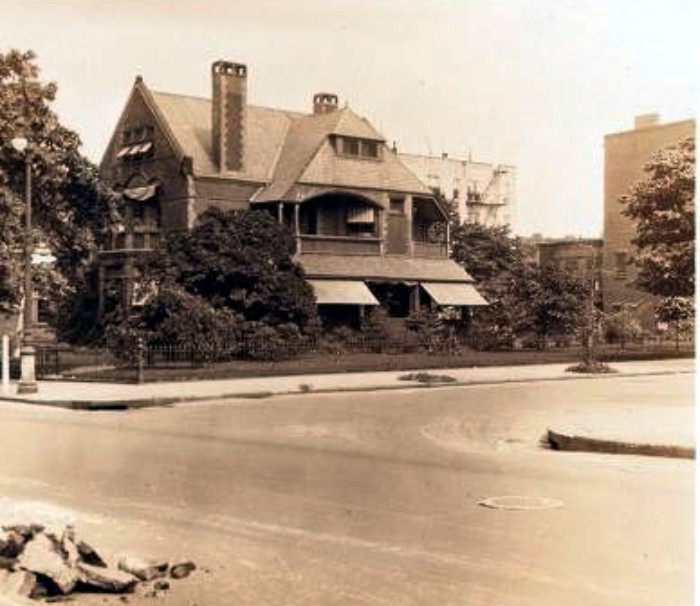
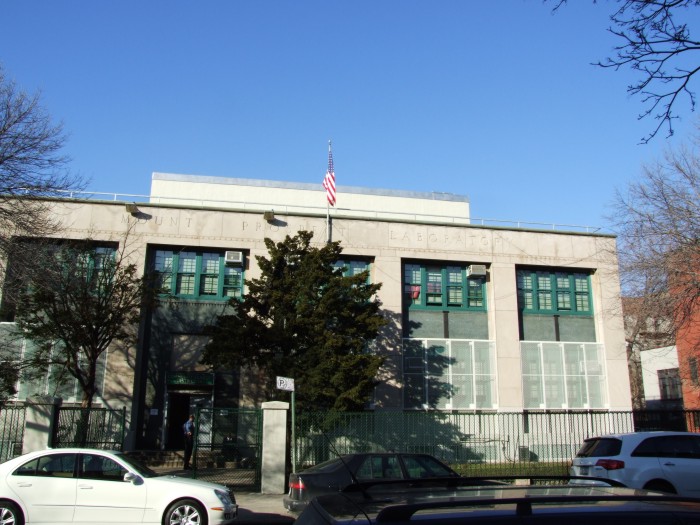
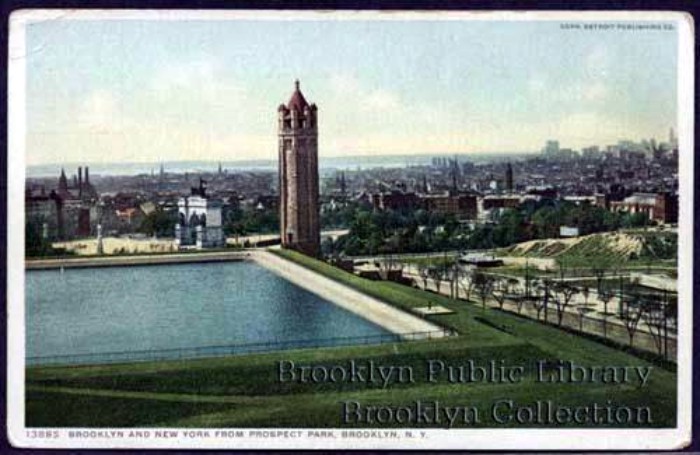
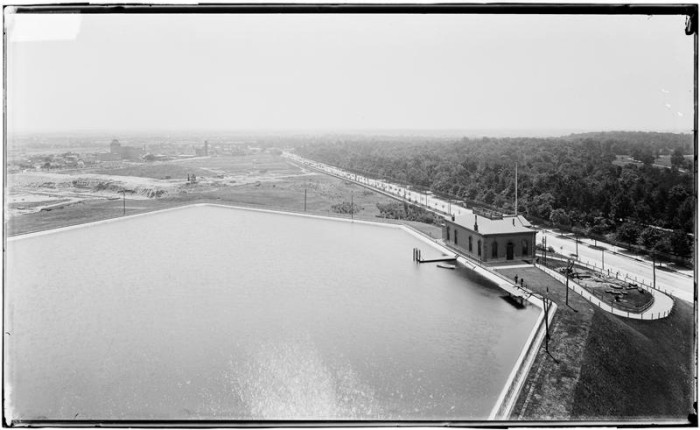





I really love this article. I live on Underhill and Park Place and look at that “laboratory,” now school, every day. It’s tragic that the original lab was torn down for the current box-like building. One correction, though, you stated the address as 353 Underhill Avenue. It’s 353 Park Place.
Where was the granite for projects like this usually sourced from? Were there quarries on long Island? Moving that much granite must have been a huge project on it’s own.